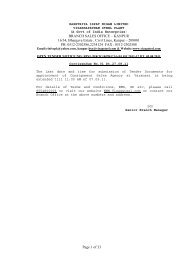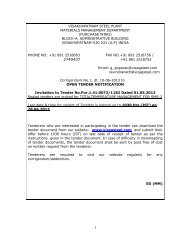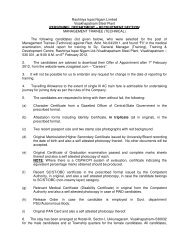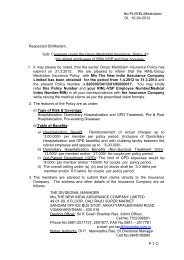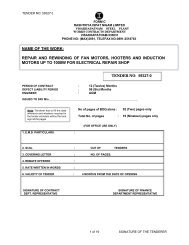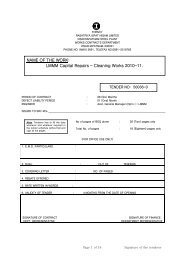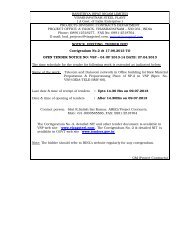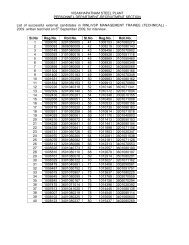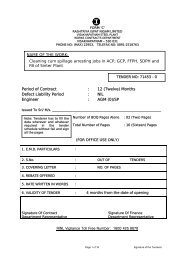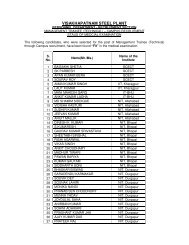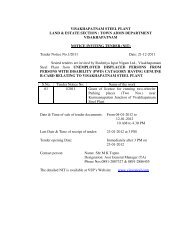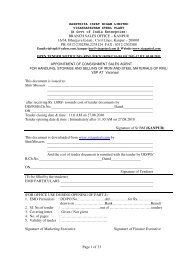Repair to BT roads at Jaggayyapet Lime Stone Mines. - Vizag Steel
Repair to BT roads at Jaggayyapet Lime Stone Mines. - Vizag Steel
Repair to BT roads at Jaggayyapet Lime Stone Mines. - Vizag Steel
Create successful ePaper yourself
Turn your PDF publications into a flip-book with our unique Google optimized e-Paper software.
2.1.3.4<br />
03 Subgrade and earthen shoulders verge Not less than 1.65 gm/cc<br />
The Engineer may, however, relax these requirements <strong>at</strong> his discretion taking in<strong>to</strong> account<br />
the availability of m<strong>at</strong>erials for construction and other relevant fac<strong>to</strong>rs.<br />
Highly expansive clays, exhibiting marked swell and shrinkage properties shall not be<br />
used in the subgrade. Where allowed these shall be deposited only in the bot<strong>to</strong>m layers<br />
of the embankment and shall not be permitted in the <strong>to</strong>p 500 mm portion of the<br />
embankment just below the subgrade.<br />
Stripping and s<strong>to</strong>ring <strong>to</strong>p soil: In localities where most of the available embankment<br />
m<strong>at</strong>erials are no conducive <strong>to</strong> plant growth, or when so directed by the Engineer the <strong>to</strong>p soil<br />
existing over the embankment found<strong>at</strong>ion shall be stripped <strong>to</strong> specified depths not<br />
exceeding 150 mm and s<strong>to</strong>red for covering embankment slopes and other disturbed areas<br />
where re-veget<strong>at</strong>ion is desired.<br />
2.1.3.5 Compacting group supporting embankment:<br />
In all cases, the original ground shall be consolid<strong>at</strong>ed by rolling, as directed by Engineer,<br />
but with a maximum of six passes of 8-10 <strong>to</strong>nnes roller.<br />
2.1.3.6<br />
In a case where there is no embankment and only the subgrade is <strong>to</strong> be constructed<br />
above the original ground and the original ground does not already have a rel<strong>at</strong>ive<br />
compaction of <strong>at</strong> least 100%, the same shall be loosened <strong>to</strong> a depth of 500 mm, w<strong>at</strong>ered<br />
and compacted in layers not exceeding 250 mm in loose thickness <strong>to</strong> the maximum dry<br />
density of the m<strong>at</strong>erial determined in accordance with IS:2720 (Pt.VII). However, before<br />
relaying and compacting the loosened m<strong>at</strong>erial, the surface below this level shall be<br />
suitably consolid<strong>at</strong>ed as directed by the Engineer but with a maximum of six passes of a 8-<br />
10 <strong>to</strong>nne roller.<br />
Where so directed by the Engineer any unsuitable m<strong>at</strong>erial Occurring in the embankment<br />
found<strong>at</strong>ion shall be removed and replaced by approved m<strong>at</strong>erials suitably compacted.<br />
Embankment or subgrade work shall not proceed until the found<strong>at</strong>ions for<br />
embankment/subgrade have been inspected by the Engineer for s<strong>at</strong>isfac<strong>to</strong>ry condition<br />
and approved.<br />
Spreading m<strong>at</strong>erial in layers and bringing <strong>to</strong> appropri<strong>at</strong>e moisture content:<br />
The embankment and subgrade m<strong>at</strong>erial shall be spread in a uniform thickness over the<br />
entire width of the embankment in layers not exceeding 250 mm in loose thickness.<br />
Succession layers shall not be placed until the layer under construction has been thoroughly<br />
compacted <strong>to</strong> the requirement set down hereunder.<br />
Moisture content of the m<strong>at</strong>erial shall be checked <strong>at</strong> the source of supply and if found less<br />
than the specified for compaction, the same shall be made good either <strong>at</strong> the source or<br />
after spreading the soil in loose thickness for compaction. Where w<strong>at</strong>er is required <strong>to</strong> be<br />
added in such constructions, w<strong>at</strong>er shall be sprinkled from a hose pipe and/or a truck<br />
mounted w<strong>at</strong>er-tank capable of applying w<strong>at</strong>er uniformly and <strong>at</strong> controlled quantities <strong>to</strong><br />
variable widths of surface but without any flooding.<br />
If the m<strong>at</strong>erial delivered <strong>to</strong> the road bed is <strong>to</strong>o wet, it shall be dried, by aer<strong>at</strong>ion and<br />
exposi<strong>to</strong>r <strong>to</strong> the sun, till the moisture content is acceptable for compaction. Should<br />
circumstances arise, where owing <strong>to</strong> wet we<strong>at</strong>her, the moisture content cannot be reduced<br />
<strong>to</strong> the required amount by the above procedure, work on compaction shall be suspended.<br />
Moisture content of each layer of soil shall be checked in accordance with IS:2720 (Part-II)<br />
and unless otherwise mentioned, shall be so adjusted, making due allowance for<br />
evapor<strong>at</strong>ion losses, th<strong>at</strong> <strong>at</strong> the time of compaction it is in the range of 1 percent above <strong>to</strong> 2<br />
percent below the optimum moisture content determined in accordance with IS:2720 (Part-




